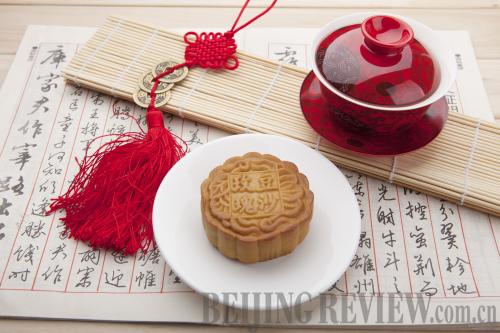|
 |
|
DELICACY: A mooncake and a teacup displayed in Jinzhou City, northeast China's Liaoning Province in September 2012 (CFP) |
However, over time the tradition of making sacrifices to the moon has given way to celebrating the full moon itself.
During the Northern Song Dynasty (960-1127), Mid-Autumn Festival was designated as an official holiday. Celebrations such as eating mooncakes became more popular around that time. It was during the Ming and Qing (1644-1911) dynasties, however, that Mid-Autumn Festival became second only to the Spring Festival in importance. Families would offer fruits and mooncakes to the moon goddess Chang'e as well as sharing them amongst family members and then they would burn "moonlight paper" which would have pictures of Chang'e or the Jade Rabbit printed on it.
Much like the Dragon Boat Festival's zongzi (glutinous rice dumpling), and the yuanxiao (rice ball) of the Lantern Festival, Mid-Autumn Festival also has its own food associated with it, as mooncakes have become an indispensable part of celebrations.
The mooncake was originally used as an offering to the moon goddess. Over time, it has developed into a symbol of family reunion and a gift to be sent to friends and family members during the festival. The methods used to make mooncakes have been improved and refined over time too. During the Ming and Qing
dynasties, bakers imprinted images—such as Chang'e's flight to the moon—into the tops of their mooncakes as decoration. The fillings used also have much more variety now than in the past, including nuts, lard, fruit paste and egg yolk. This coupled with regional differences in the recipes makes for a huge variety of different flavors and textures between mooncakes.
"The best way to eat mooncakes is to have them with Chinese tea as they are slightly oily," says Yin Zhiwen, a baker at Beijing's Daoxiangcun, a popular Chinese brand of pastries and cakes. "Chinese tea can also help with digestion as well as accent and compliment the flavor of the mooncakes."
Another custom, which is equally as important to Mid-Autumn Festival as the eating of mooncakes, is viewing the full moon on the night of the festival. Today, sitting together with family members to appreciate the moon together is still considered an important part of the festival celebrations.
In addition, different regions have their own unique Mid-Autumn customs. For example, in Jianning, located in southeast China's Fujian Province, people hang lanterns while the people of Chaoshan in Guangdong eat taro.
The festival in modern times
Today, although few Chinese know much about the festival's origins, most of them recognize it as an important traditional festival and a time for family reunion.
"For me, Mid-Autumn Festival means that I can have three days off and can visit my parents," Dou Huining, a 23-year-old civil servant, said.
However, for overseas Chinese, celebrating Mid-Autumn Festival is an important way for them to keep in touch with the culture of their ancestors.
"It is an opportunity for families to come together and educate the next generation (about Chinese traditions)," said Cathy Hung, Executive Director of the New York Chinese Culture Center. "It's incredibly important to preserve tradition, especially in a distant land. You keep your heritage alive by sharing with your children what you experienced as a child."
Email us at: jijing@bjreview.com | 